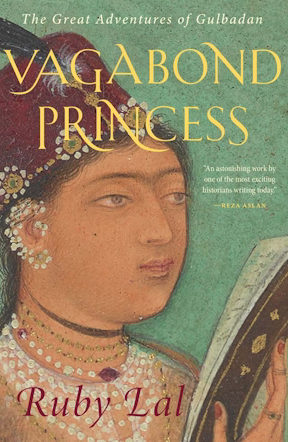Vagabond Princess: The Great Adventures of Gulbadan
- By Ruby Lal
- Yale University Press
- 280 pp.
- Reviewed by Larry Matthews
- April 2, 2024
A detailed if dry portrait of 16th-century Central Asia.

Let me say at the outset that Vagabond Princess: The Great Adventures of Gulbadan isn’t much about Princess Gulbadan. Rather, it’s about the times in which she lived, although she does make appearances. The book was written by Ruby Lal, a professor at Emory University, and her research — which draws heavily on Gulbadan’s own memoir — is impressive, especially if you have an interest in 16th-century India and its environs.
“Gulbadan, literally ‘Rosebody,’” explains Lal, “was the beloved daughter of Babur, the patriarch of the magnificent Mughals of India, and the first and only woman historian of the Mughal Empire.”
The author continues, “Theirs was a universe marked by war, movement, and varied events that led to war.” That’s the backdrop that defined Gulbadan’s life, which was one of unimaginable privilege:
“Mughal princesses and queens lived in their own individual quarters, attended by a large staff that focused on their needs. Among them were midwives, scribes, lamplighters, pages, stewards, doorkeepers, oil keepers, cooks, tasters, tailors, palanquin bearers, water carriers, perfumers, weavers and masons.”
This is Gulbadan’s world — wealth, conflict, and movement from one place to another. Lal digresses into the history and culture of each locale Gulbadan visits, from Kabul to Arabia and beyond. The princess’ clothes, food, rooms, and gardens are presented as part of the mosaic of her life, extravagant as it was.
The book is also rich with detail about a region that has known unrest for millennia: an area that now includes parts of the Middle East, Iran, and Afghanistan. Over the centuries, power there ebbed and rose. Alliances came and went. Conflict was constant. So was the movement of the royals. One such journey began in Kabul in January 1529:
“The princess and her family were carried part of the way on palanquins, covered berths padded with soft mattresses and thick draperies hung from poles, born by strong bearers…Clad in heavy wool shawls that went atop and around their conical hats, the women would switch to horses or boats when necessary.”
Poetry, music, books, and art were prized in that era, and Gulbadan was highly educated, cultured, and cherished by her family — people devoted to their own indulgences and brought to life through Lal’s prodigious research. Still, I found myself wondering about the lamplighters, oil keepers, tasters, water bearers, and others who catered to the monarchs’ every whim. They were, in practicality, irrelevant outside their roles in service to the court.
The “great adventures” of the book’s title refers to the extensive traveling that was required of Gulbadan, including her Haj to the Ka’ba in Mecca — a pilgrimage to the most sacred site in Islam in what is today Saudi Arabia.
“The wide open quad with the Ka’ba where Gulbadan stood had been so for centuries, inviting everyone to step into the holy precincts and garner blessings,” writes Lal. As Gulbadan beheld the sight, the author relates, “Her joy was palpable.”
Readers eager to understand 1500s Central Asia will relish this lush repository of colorful material about its most privileged figures. Casual readers, on the other hand, might get a bit bored. While Vagabond Princess is on one level an academic (aka dry) account of a specific time and place, on another, it’s a PR-like chronicle of a long-ago princess’ world, complete with fawning praise. Your enjoyment of the book likely hinges on whether one or both of these things sound appealing.
Larry Matthews is the author of Take a Rifle from a Dead Man and other books.
_80_123.png)
_80_121.png)